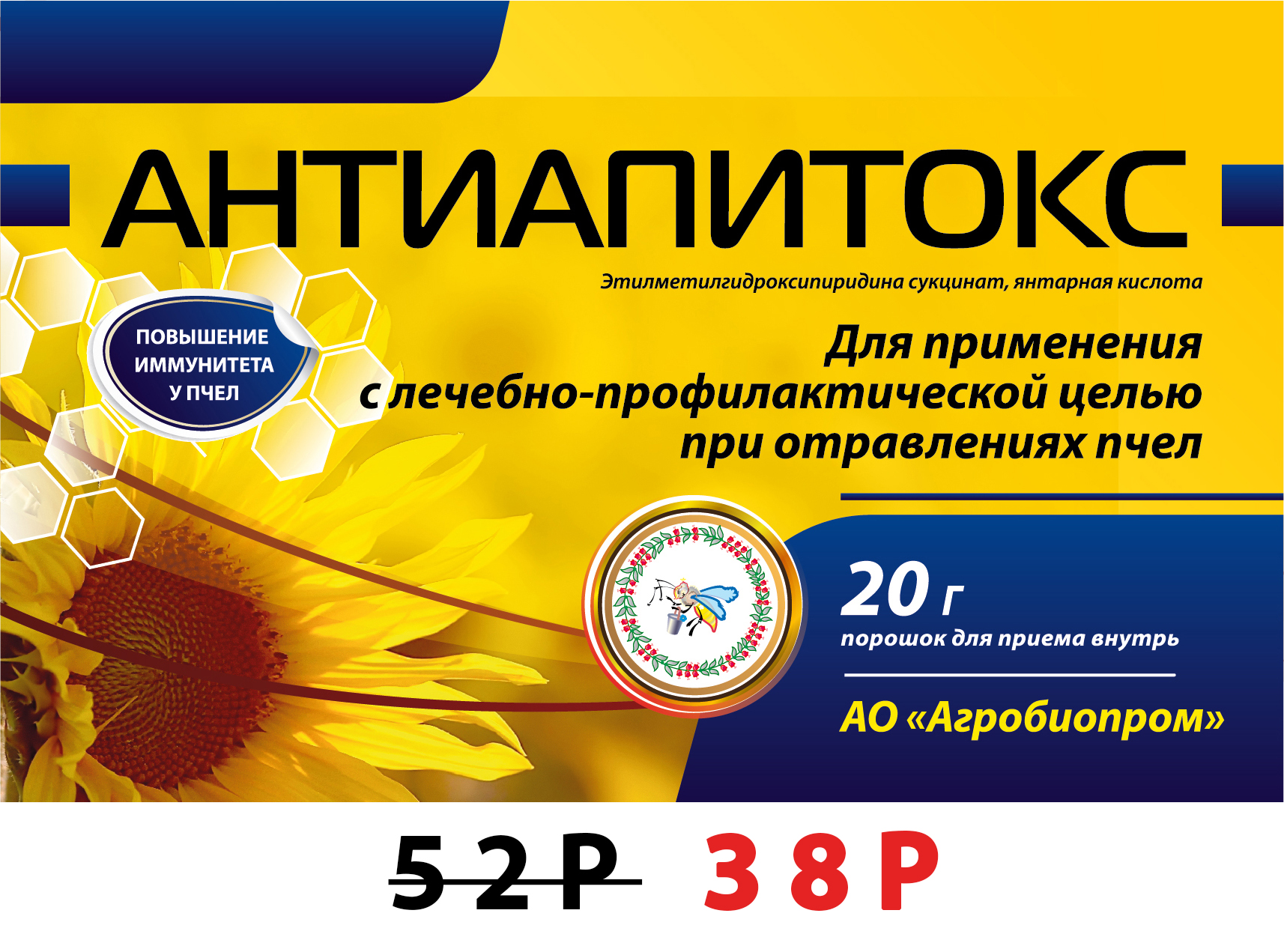ANTIAPITOX 20 g

Powder for oral administration.
Antiapitox contains the following as active ingredients in 1 g of the drug: ethylmethylhydroxypyridine succinate 20 mg, succinic acid 100 mg, and excipients.
The drug is manufactured in a form of a powder from white to light gray in color, the presence of a yellowish or cream shade is allowed.

Pharmacotherapeutic group of the veterinary drug: detoxifying agents in combinations.
The drug helps to cleanse the body of bees from toxins, as well as stimulates the immune system’s functioning and adaptive capabilities.
Ethylmethylhydroxypyridine succinate strengthens the body’s resistance to various damaging factors and is used for the treatment of acute poisoning. It reduces the amount of toxins in the body.
Having an antioxidant effect on the organism, it inhibits the chain of oxidative reactions and eliminates free radicals. The mechanism of action is driven by its antihypoxant, antioxidant, and membrane-protective effect. It inhibits the processes of lipid peroxidation, stimulates the activity of superoxide dismutase, increases the «lipid-protein» ratio, reduces the membrane viscosity, and increases its fluidity.
Succinic acid strengthens the immune system, restores the energy potential of cells in case of intoxication, promotes the elimination of toxic substances from the body, and stimulates adaptive capabilities to the changing environmental conditions.
According to the degree of exposure to the organism, Antiapitox refers to low-risk substances, in the recommended doses, it does not have a local irritating and sensitizing effect.
Antiapitox is low-toxic for bees, does not adversely affect the general condition, development and productivity of bee colonies.

Antiapitox is used for therapeutic and preventive purposes to protect bees from poisoning by toxic substances of various origins, stimulate the immune system function and adaptive capabilities to the changing environmental conditions, which leads to increased resistance, productivity, an extended period of economic use, and a high percentage of bee colonies recovering from wintering.
It is prohibited to use the drug less than 14 days before the start of the main honey harvest in order to avoid the ingress of the components of the drug into commercial honey.
When using a product, the general rules of personal hygiene and safety provided for when using drugs should be observed. Empty packaging from under the drug is prohibited to be used for household purposes, it is subject to disposal with household waste.
In case of accidental contact of the drug with the skin or mucous membranes of the eyes, they must be rinsed with plenty of water. People with hypersensitivity to the components of the drug should avoid direct contact with it. In case of accidental contact of the drug with the skin or mucous membranes of the eyes, they must be rinsed with plenty of water. In case of allergic reactions or accidental ingestion of the components of the drug into the human body, you should immediately contact a medical institution (take the patient information leaflet or label with you).
Antiapitox is used in spring and autumn a week before the antivarroat treatment of bee colonies and at the first signs of toxicosis (poisoning) by nectar, pollen, or honeydew. In summer, use this drug a week before the expected treatment of crops with pesticides, as well as at the first signs of chemical or salt toxicosis.
The drug is used with sugar syrup at the rate of 2 g of the drug per bee colony comprising 10–12 beeways.
To prepare a drug syrup, dissolve 20 g of the drug in 100 ml of warm water, and then mix it with 10 liters of sugar syrup prepared in a 1 : 1 ratio (or dissolve 40 g of the drug in 100 ml of warm water, and then mix it with 20 liters of sugar syrup prepared in a 1 : 1 ratio; or dissolve 60 g of the drug in 100 ml of warm water, and then mix it with 30 liters of sugar syrup prepared in a 1 : 1 ratio), then place the drug syrup to clean feeders and feed it to bees at the rate of 100 ml per frame with bees.
Administer Antiapitox to bees for preventive purposes 3 times with an interval of 2–3 days, and for therapeutic purposes – 4–5 times with an interval of 3 days.
In poisoned bee colonies, reduce and insulate the nests, and then remove the frames with fresh nectar and bee bread. In the nests, redistribute the brood, leaving enough for the bees to incubate it completely.
Perform mechanical cleaning of the released hives, wash them with a 5% alkali solution, and then with clean warm water.
Melt honeycombs with honey and bee bread from dead colonies into wax, which is to be used for technical purposes only.
Replace all the honeydew and crystallizing honey in the bees’ nests with good honey.

The specifics of the action during the first use of the drug and its cancellation have not been established.
NB! Avoid the prescribed dosage and prescribed administration pattern violations, as this may lead to suboptimal effectiveness. If the next drug dose is missed, it should be administered as soon as possible in the same dose, according to the same pattern.
Honey may be consumed not before 14 days after the end of the drug administration in accordance with this instruction.
It is released without a prescription from a veterinarian.

Antiapitox is released packaged, 20 g in hermetically sealed bags of appropriate capacity made of metallized film. Each consumer package contains a patient information leaflet.

Store the drug in the original closed package, protected from direct sunlight, separately from food and feed, at a temperature of 0 to +25°C.
Keep out of reach of children!
It is released without a prescription from a veterinarian.
The unused drug is disposed of in accordance with the requirements of the legislation.

The drug shelf life, subject to compliance with storage conditions in the original unopened container, is 3 years from the date of manufacture. Do not use the drug after the expiration date.



